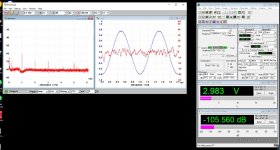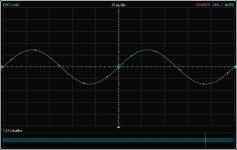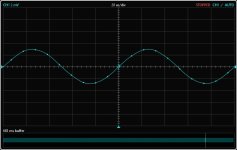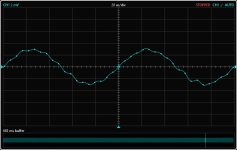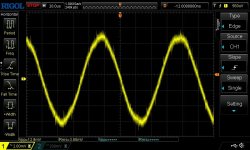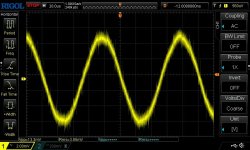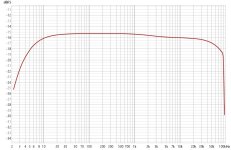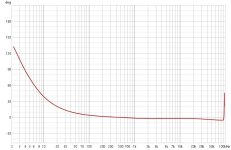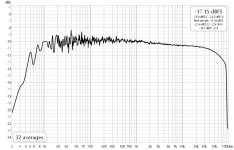I have used a variety of 8 bit DSO over the years and found them fine for digital work and observing pulses, sine waves, triangle and ramps are a different matter where the stair step was highly visible in single acquisitions (I used averaging for repetitive wave forms which worked well.) One example of where I have had problems is low level sine waves where attenuation options resulted in waveforms of occupying just 1 or 2 divisions, almost unusable due to quantization and noise performance.Having used a vareity of scopes for many tasks I'm at a loss on how to use 12+ bits when looking at a waveform. The screen doesn't have the resolution to see it all and vertical magnification is useful only to a degree in specific applications (ones that my Tek 7A13 differential comparitor does well). Frequency domain is another issue. However for audio band a good audio ADC (Cosmos?) is hard to beat (20+ ENOB) and software like Virtins allows some pretty amazing analysis.
I have a 20 inch monitor and can display a pretty high quality low amplitude sine wave over a wide range of attenuator settings.
The other benefit is my Picoscope has a good, usable spectrum analyzer at audio frequencies (16 bit quantization single channel 15 bits two channel) and selectable spans out to 60MHz. And it's really easy to use.
I have an RTX-6001 and Virtins, good to 90kHz with 24 bit quantization, not intuitive in use since I don't use it enough to become completely familiar with it. For simple measurements I would recommend audiotester.de over REW which I use mainly for acoustical and room measurements.
I have an 8 bit Rigol 4 channel DS1054Z I bought for work years ago, it's nice has acceptable, but mediocre performance with sine waves, ramps and triangles.
I think the new 12 bit Rigol and Siglent scopes are a big step forward for analog work and recommend them to friends. Not much more money than a run of the mill 8 bit scope.
YMMV
Oh my, yes that's expensive, though very good performance.I have a Picoscope 5242D 60MHz dual channel scope, it is sort of expensive
I don't mind a USB interface, for one thing the display is on a bigger screen. This thing appears to give good performance on a budget. I've been looking at it off and on for a few years, what does anyone think?
https://digilent.com/reference/test-and-measurement/analog-discovery-2/start
2 channels 14 bit, 10MHz bandwidth and 16 logic inputs.
I have a Focusrite Scarlett 2i2 interface, with 44.1/48/96k sampling rates, but the frustrating thing about these "audio" interfaces is none that I've seen give frequency response above 20kHz. Has anyone actually measured them, and perhaps put the results on a webpage?
FWIW here is my setup with an AP system 1 and a Picoscope ADC 200-100 sharing a PC and screen. In this application the vintage 8 bit unit is more than adequate. There is a bunch on e-bay https://www.ebay.com/itm/1863168146...PzQR1X0dKrKFJdmKrF/JCSO9H9|tkp:Bk9SR9Cdlam-Yw and the old paralel port units can be made to work in a modern desktop PC. I find the PC scope klutzy for troubleshooting but great for waveform monitoring.
Attachments
You had to mention ASR - I looked into this there a a few months back, I was going to post the question, but decided to see if it's already answered. it seems few if any there care about response above 20kHz, yet at least one of those cares a lot about each of his 20kHz waveform cycles being reproduced by four or eight samples.
I found the 2i2 review, it's somewhat helpful. The output noise going up above 20k "seems right" for a DAC meant solely to reproduce up to 20kHz, and the delta-sigma conversion pushing up the noise to just above that, regardless of the sample rate.
I vaguely remember in the newsgroup rec.audio.pro, interfaces would have a frequency response to near half the sample rate, at any sample rate. Those guys knew what they were doing, and would be upset if the didn't get the full bandwidth they were paying for.
I found the 2i2 review, it's somewhat helpful. The output noise going up above 20k "seems right" for a DAC meant solely to reproduce up to 20kHz, and the delta-sigma conversion pushing up the noise to just above that, regardless of the sample rate.
I vaguely remember in the newsgroup rec.audio.pro, interfaces would have a frequency response to near half the sample rate, at any sample rate. Those guys knew what they were doing, and would be upset if the didn't get the full bandwidth they were paying for.
Yes, the analog discovery v1 to v3 all have 14 bits, but need a PC. Their software is supposed to be great for automation, but not really a good on-screen scope software. Bandwidth is limited, too.
I wonder why noone has mentioned Owon? Their XDS2102A 12 bit / 100 MHz scope has been around for about 5 years. Used to be ~ € 330 from China, now is more expensive from there than it is from a real shop in Germany including 19% VAT (€ 400). They have steadily expanded their line of 12 and 14 bit scopes. I watched a few video reviews, there seems to be nothing seriously wrong with those scopes.
In comparison, how are the Rigol and Siglent? Traditionally, I would have assumed Owon < Rigol < Siglent? The Rigol didn't seem to offer much beyond the Owons, based on the one video review I watched, and are still more expensive. I was surprised to see the smallest of the new siglents SDS802X HD (12 bit, 2 ch, 70 MHz) for € 359 including VAT from a reputed dealer in Germany. The equivalent DHO802 Rigol is € 415 at the same dealer.
The advantage of the Rigol is probably that it can be more easily upgraded by software?
I wonder why noone has mentioned Owon? Their XDS2102A 12 bit / 100 MHz scope has been around for about 5 years. Used to be ~ € 330 from China, now is more expensive from there than it is from a real shop in Germany including 19% VAT (€ 400). They have steadily expanded their line of 12 and 14 bit scopes. I watched a few video reviews, there seems to be nothing seriously wrong with those scopes.
In comparison, how are the Rigol and Siglent? Traditionally, I would have assumed Owon < Rigol < Siglent? The Rigol didn't seem to offer much beyond the Owons, based on the one video review I watched, and are still more expensive. I was surprised to see the smallest of the new siglents SDS802X HD (12 bit, 2 ch, 70 MHz) for € 359 including VAT from a reputed dealer in Germany. The equivalent DHO802 Rigol is € 415 at the same dealer.
The advantage of the Rigol is probably that it can be more easily upgraded by software?
Last edited:
Found the BG listing (€ 75 cheaper then German dealer who in turn offers 3 year warranty) but it doesn't say anything about the upgrade. Did you mean you found out how to upgrade it after taking delivery?I looked at used units, various 2-4 channel Rigol and Siglent.
A Rigol DS1054Z went for £250; a Siglent SDS1104X-E is £425 on eBay. Both 8-bits.
Then I found the Rigol DHO800-900 range.
£354 via Banggood for a new DHL804 - 4 channels, 12-bit, can be supplied by USB battery power, 70MHz and software upgrade to 200MHz. Small form factor and a big touchscreen.
It's a bit more than I originally intended but these units will replace the DS1054 as the obvious choice for a starter oscilloscope.
Btw Siglent has reduced the prices of their budget units.
I bought the DHO804
Last edited:
The rigols and siglents both have software upgradable bandwidth usually. My 4000 starts at 200MHz but can go to 800. In my case rigol was running a free 200->400 promotion. So the scope arrived running at 200, and then they sent a key which after I entered made it a 400. You can buy the upgrade and I am pretty sure some have hacked them. Note that voids warranty. I don't know about siglent, but rigolna offers free shipping when you buy in the US. They also run promotions and have a clearance center. I've used both and had no issues.
@capslock There are threads on EEVblog.com about upgrading the firmware on the Rigol 800 series - hardware seems to be the same between the 2- or 4-channel units, ditto for the 900 series, and some discussion of getting part of the functionality of the 900 onto the 800 with some hardware mods.
Thanks, found them. The new Siglent line still seems to be suprior. It's just so new it hasn't been hacked yet. Pity only the 200 Hz versions of Siglent seem to have more memory, then again, when does one need 200 MHz for audio, and if I ever did I could always drag up the trusty Tek 485 from my basement.
Since extra channels cannot be added by a hack: is there ever a compelling use case for four channels in audio? I've been happy with two up to now.
Since extra channels cannot be added by a hack: is there ever a compelling use case for four channels in audio? I've been happy with two up to now.
Last edited:
REW scope display is not crude. It has the basic adjustments of an oscilloscope (not yet an X-Y mode).Have you tried REW with a usb interface? REW offers a crude scope display. May be enough for your time domain stuff.
The basic difference is in the display of the signal, as displayed waveform is bandlimited to 1/2 the sampling rate of the soundcard.
Sometimes this is a feature (cleaning up a noisy signal), other times this is a limitation (don't see HF self oscillation)
Below is a weak 10kHz noisy signal.
George
Attachments
This is from the Creative E-MU 0404 soundcard.I have a Focusrite Scarlett 2i2 interface, with 44.1/48/96k sampling rates, but the frustrating thing about these "audio" interfaces is none that I've seen give frequency response above 20kHz. Has anyone actually measured them, and perhaps put the results on a webpage?
Loopback test@192kHz sampling rate
George
Attachments
Last edited:
Since extra channels cannot be added by a hack: is there ever a compelling use case for four channels in audio? I've been happy with two up to now.
You could watch what your rail voltages are doing, together with the output(s).
The picoscopes both arrived today and I had a chance to test both. This is 12 bit of the same as above:

And this is 16 bit:

in this application not much difference.
I'm sure there w be in other applications
FWIW the old parallel port Picoscopes are quite a value if you have a parallel port (no USB parallel ports) and a 32 bit Windows.
And this is 16 bit:
in this application not much difference.
I'm sure there w be in other applications
FWIW the old parallel port Picoscopes are quite a value if you have a parallel port (no USB parallel ports) and a 32 bit Windows.
Since extra channels cannot be added by a hack: is there ever a compelling use case for four channels in audio? I've been happy with two up to now.
If you're into digital audio then having more than 2 channels makes checking I2S channels (3 or 4 signals) easier.
The 12 bit Picoscope is an ADC212/100 and the 16 bit is an ADC216. The 16 bit does have a larger dynamic range. What you are seeing is the Monitor and "reading" outputs of the AP S1. The composite value of the displayed noise is -110 dB from 2V at the input of the AP. For a very clean source there isn't much to see, just some very low level harmonics. The 16 bit FFT shows lots of blank space. The 16 bit scope has a max full scale sensitivity of 10 mV which make a lot of sensitivity with 16 bits. However this version has an 80 KHz bandwidth. The later one has more but costs Much much more.
The Picoscope software has a lot of options. The linear frequency scale makes it easier to see harmonics.
The Picoscope software has a lot of options. The linear frequency scale makes it easier to see harmonics.
- Home
- Design & Build
- Equipment & Tools
- Modern Digital Oscilloscopes are amazing for their price
